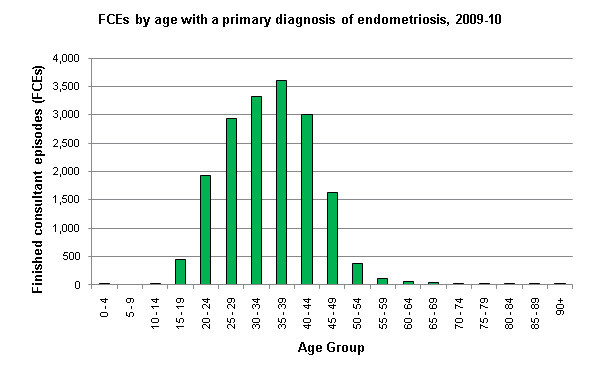
- NHS Choices: Endometriosis
- Endometriosis UK
- Inpatient data
- Self Service
HES on... Endometriosis
Endometriosis affects an estimated two million women in the UK, according to NHS Choices. This article gives an overview of the condition and highlights related 2009-10 HES data.
What is endometriosis?
Endometriosis is a condition where patches of the endometrium (the inner lining of the womb) appear in parts of the body other than the womb, such as the fallopian tubes, ovaries or lungs.
During a menstrual cycle, the endometrium thickens and increases its blood supply in preparation for the release of an egg. The body then sheds the endometrium if the egg is not fertilised. Endometrial tissue undergoes this process no matter where it is in the body, which can lead to pain, swelling and bleeding in those areas.
Who does it affect?
Endometriosis affects women. According to NHS Choices, most women diagnosed with the condition are between 25 and 40 years old. HES data shows that most patients treated in hospital in 2009-10 were between 25 and 44 years old (see graph below).
 |
However, endometriosis can occur at any time from the onset of menstrual periods to the menopause, and beyond (in a few, extremely rare cases).
HES facts and figures
HES data for a primary diagnosis of endometriosis (diagnosis code N80 in ICD-10) shows that
- the most common instances of endometriosis are of the pelvic peritoneum (N80.3), ovaries (N80.1) and uterus (N80.0).
- the majority (87%) of hospital admissions for endometriosis are from waiting lists, rather than emergencies.
- the average (median) time that patients waited before treatment was 56 days (according to HES time waited figures).
- the three most common procedures carried out on patients were:
- Therapeutic endoscopic operations on peritoneum (T42, OPCS-4.6).
- abdominal excision of uterus (Q07, OPCS-4.6).
- diagnostic endoscopic examination of peritoneum (T43, OPCS-4.6).
- it was responsible for 17,624 episodes of admitted patient care, accounting for 22,043 FCE bed days.
More information on this topic is available from NHS Choices here.

